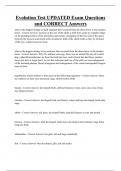Evolution Test UPDATED Exam Questions
and CORRECT Answers
what is the biggest change in skull anatomy that occurred from the dawn horse to the modern
horse - Correct Answer- increase in the size of the skull; a shift from cusps to complex ridges
on the grinding surface of the premolars and molars, elongation of the face and of the space
between the incisors and cheek teeth, an anterior shift of the cheek teeth so they lie forward
of the eye; a deep lower jaw bone
what is the biggest change in leg anatomy that occurred from the dawn horse to the modern
horse - Correct Answer- fifty five million years ago, there was an animal the size of a small
dog, called Hyracotherium. its front feet had four toes, and its back feet had three. modern
horse feet have a single hoof. we see the reduction and loss of the side toes and enlargement
of the terminal phalanx (hood) elongation and enlargement of the central metapodial (longest
bone in foot)
hypothesize which embryo is from each of the following organisms - Correct Answer- these
are embryos at their most advanced stage, shortly before birth
human - Correct Answer- developed limbs, defined features in face, neck, ears, loss of tail,
tiny fingers present
chicken - Correct Answer- developed beak, tail shorter, wings and legs developed, head quite
large
rabbit - Correct Answer- tail gone, developed limbs, detailed features in ears and mouth
tortoise - Correct Answer- shell developed, limbs have developed, tail is thinner, large belly,
long tail, beak
salamander - Correct Answer- has gills, tail and large underbelly
fish - Correct Answer- fins developed, gills, tail and scales
, look again at the six embryos in their earliest stages. describe the patterns you see. what
physical similarities exist between each of the embryos? - Correct Answer- same basic shape,
circular spots (eyes) and underbelly, all have tails, tiny bumps on underside, hole for ear
does this suggest an evolutionary relationship? explain how these embryos can be used as
evidence of a common ancestor between each of these six organisms - Correct Answer-
examination of vertebrate embryos reveals that during corresponding stages of early
development, the embryos appear to be very similar. all vertebrate embryos pass through
stages in which they have gill pouches. the pouches eventually develop into the gill apparatus
in fish; in later- evolving vertebrates that do not have gills, the gill pouches undergo further
refinement and develop into structures associated with the head and neck. all early vertebrate
embryos have tails, which persist in some animals but regress during the later stages of
development of humans. thus, the individual development of an animal occurs through a
series of stages that paint a broad picture of the evolutionary stages of the species to which it
belongs
animal primary functions- whale - Correct Answer- swimming
animal primary functions- cat - Correct Answer- running, walking, jumping
animal primary functions- bat - Correct Answer- flying, flapping wings
animal primary functions- bird - Correct Answer- walking, hopping
animal primary functions- crocodile - Correct Answer- swimming, walking/crawling
comparison to human arm in form and function- whale - Correct Answer- FORM- much
shorter and thicker humerus, radius, and ulna and much longer metacarpals FUNCTION- fin
needs to be longer to help in movement through water. thumbs are not necessary, as they don't
need to pick up and grasp things
comparison to human arm in form and function- cat - Correct Answer- FORM- curved
humerus, shorter thinner humerus and ulna and radius, smaller metacarpals and phalanges
FUNCTION- movement involves jumping and running, smaller for agility and balancing on
small ledges, no thumbs for grasping since they use claws and teeth for this.




